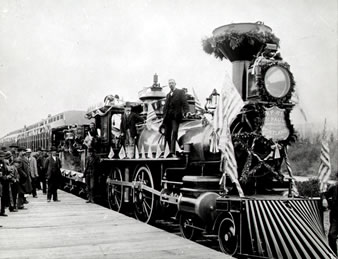
Lesson Fourteen:
Industrialization, Technology, and Environment in Washington
This classic view commemorates the completion of the Northern Pacific Railroad (left) transcontinental line in 1883 as it ran from St. Paul, Minnesota to Tacoma by way of Portland. (Special Collections, University of Washington, negative #594.)
Logging railroad, (below). (Special Collections, University of Washington, neg. #12093)
The arrival of transcontinental railroads in the Pacific Northwest during the 1880s marked one of the key turning points in the region's history. The Northwest had been integrated into global trading networks since the 1780s, when British vessels began carrying away sea otter pelts to China; and the Northwest had been integrated into far western trading networks since the time of the Gold Rush, when California's demand for produce and lumber had sent ships to regional shores. Yet as late as 1880 the Pacific Northwest remained largely isolated from both the main currents of the global economy and the bulk of the population in the United States. From the writings of people like James Swan, Americans knew that the Northwest possessed resources to be exploited. Yet other parts of the country generally provided plenty of the kinds of resources that the Northwest had to offer, and the place remained too inaccessible for most people. Consider, for example, the extent to which people homesteaded in the region. Between 1862 and 1880, only 9,800 people in Oregon and 9,500 in Washington filed homestead claims; by contrast, 62,000 and 59,000 filed claims, respectively, in Minnesota and Nebraska—states located closer to, and served better by railroads from, eastern centers of population.
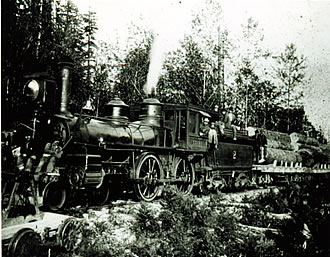 The population of Idaho, Oregon, and Washington in 1880 amounted to no more than 283,000. After the arrival of transcontinental lines during the 1880s, the number of people grew quickly. By 1910 the three states contained more than 2 million residents. The substantial increase resulted in large part from the arrival of railroads, which brought more people to settle in the region, more investments in the extractive economy, more awareness of opportunities, and more of a means to increase exports to the rest of the world. No longer so remote, the Northwest became even more integrated into the networks of the global economy and the commerce of the United States. Boosters exuded confidence that the railroads would elevate the regional economy, and perhaps even put the Northwest on a par with other parts of the country. They were gratified to get the attention of big capitalists from the East and Europe, to be the focus of advertising campaigns, to become the destination for thousands of new migrants. They embraced the new cities and new commerce that railroads helped to create. However, many booster's hopes were misplaced. Railroads may have liberated the Northwest from its isolation and accelerated its pace of settlement, but they brought with them their own constraints and limitations. In some ways they heightened the sense that the Northwest was the colony, the hinterland, of other places.
The population of Idaho, Oregon, and Washington in 1880 amounted to no more than 283,000. After the arrival of transcontinental lines during the 1880s, the number of people grew quickly. By 1910 the three states contained more than 2 million residents. The substantial increase resulted in large part from the arrival of railroads, which brought more people to settle in the region, more investments in the extractive economy, more awareness of opportunities, and more of a means to increase exports to the rest of the world. No longer so remote, the Northwest became even more integrated into the networks of the global economy and the commerce of the United States. Boosters exuded confidence that the railroads would elevate the regional economy, and perhaps even put the Northwest on a par with other parts of the country. They were gratified to get the attention of big capitalists from the East and Europe, to be the focus of advertising campaigns, to become the destination for thousands of new migrants. They embraced the new cities and new commerce that railroads helped to create. However, many booster's hopes were misplaced. Railroads may have liberated the Northwest from its isolation and accelerated its pace of settlement, but they brought with them their own constraints and limitations. In some ways they heightened the sense that the Northwest was the colony, the hinterland, of other places.
If the railroads exported the Northwest (or at least its products) to the East, they also imported the East to the Northwest. By that I mean two things. First, railroads transported to the remote region the social and cultural and economic and political traits that characterized Gilded Age America. By conquering distances between different corners of the country, railroads helped to disseminate the modernizing ways of the late 19th century. The Northwest received as a result an intense dose of urbanization, industrialization, and immigration—and it came at a formative time when social institutions were beginning to jell. Outside of the Willamette Valley, industrialism found few entrenched institutions within Anglo-American society that were capable of resisting or buffering its ways. Second, railroads came with strings attached, and these strings took the form of conditions determined by people back East. No western town, territory, or state had the resources to build a transcontinental line itself. As a result, they relied upon cooperation between the federal government and finance capitalists to obtain rail connections, and they had to live with the terms that those eastern "benefactors" laid down. They had to accept, for example, the bargain struck between Congress and the Northern Pacific Railroad which granted the company immense tracts of western lands as an incentive for building the line. Most of all, they had to learn to live with the enormous influence that railroad companies exerted on their societies.
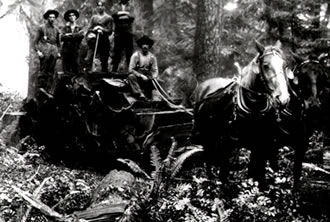
Follow this link for more Logging Scenes.
Railroad companies immediately became the most powerful economic actors in the Pacific Northwest, and they toiled to shape its economic development to their benefit. They built or expanded towns, for example, where it best suited (or profited) them, often leaving bypassed sites to wither. They became the largest private landowners in the region, and wielded enormous influence over the distribution and utilization of land. Moreover, they became the biggest boosters of the Pacific Northwest. They distributed millions of flyers and pamphlets and broadsides to advertise the area, not just in the eastern states but also in Europe, and they hired agents to encourage emigration to the Northwest. Railroads profited in multiple ways from the population influx that they encouraged. For example, they charged fares to passengers migrating to the region; they sold land to many of the newcomers; and they shipped back east the produce or natural resources that the newly enlarged population generated. They also formed companies to develop the region's land and resources on a much larger scale. The amount of economic activity increased dramatically because of their arrival; yet the powerful railway companies naturally directed much of that activity, making it hard for Northwesterners to feel that they had been "liberated," in economic terms.
One sphere in which railroads expedited growth was the logging industry. The first explorers and fur traders had noticed the abundant timber and made some economic use of it, and the California Gold Rush created a demand for Northwest wood products that really launched the lumber industry. Between 1860 and 1880, eight out of every ten dollars invested in manufacturing in Washington Territory went to the timber industry. Yet these remained slack years with wildly inconsistent levels of production, and many sawmills struggled to stay in business. As late as 1880, Washington ranked 31st among all states and territories in timber production. Over the next decade, however, its output multiplied eight times, and by 1890 it had risen to fifth in the United States; by 1905 it ranked first, and it continued to lead the nation for every year but one until the 1930s. The arrival of railroads had suddenly accelerated timber production. (Another key factor was that in this era the forests around the Great Lakes began to give out, after having been harvested for decades, and timber companies such as Weyerhaeuser moved to the Pacific Northwest to get new supplies of wood.)
Railroads stepped up timber production in myriad ways. First, they were enormous consumers of wood products themselves, using 20-25 percent of the annual timber production between the 1870s and 1900 for railroad ties, bridges, stations, fences, and fuel. Second, railways enabled loggers to penetrate deeper into the forests by providing access to many more trees than before. Third, as owners of enormous amounts of land, railroad companies treated forests as private property and worked both to develop and to conserve timber resources. Fourth, they imported to the Pacific Northwest more machinery and more people than ever before, and put them to work in the timber industry. Fifth, they lowered the cost of transporting logs out of the forests to mills, and from mills to the eastern states. In short, railroads were machines that revolutionized the timber industry.
Just as railroads "mechanized" and accelerated production throughout the economy of the Pacific Northwest, the "steam donkey" further mechanized and accelerated production in the timber industry. Steam donkeys were introduced during the 1880s to replace the ox and horse teams that hauled fallen logs out of the forest. By 1900, Washington had three times the number of steam donkeys of Oregon and California combined. Not coincidentally, its production of lumber skyrocketed.
Follow this link for more Fishing Scenes
|
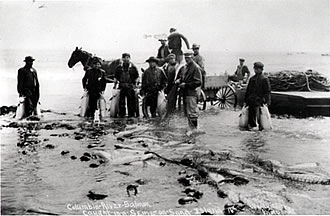 |
|
||||||||||||||||||||||||||||
This kind of productive growth was hardly limited to timber. The industrialization or mechanization symbolized by railroads and steam donkeys revolutionized every extractive industry. The fishing industry underwent its own considerable changes, as the story of three technological innovations illustrates. The development of internal combustion engines during the early 20th century enabled fishing boats to travel further in pursuit of fish and made it much easier for crews to handle large nets and catches. The invention of the so-called "iron chink" during the first decade of the century expanded the productive capacity of canneries by mechanizing the process of salmon butchering. ("Chink" was, of course, a derogatory word for Chinese. The "iron chink" was named and marketed as a machine that both replaced and improved upon the highly skilled Chinese salmon butchers who had occupied such an important position in the canneries.) Finally, as Northwesterners began to worry, as early as the 1870s and 1880s, about the depletion of runs of salmon in the region's streams, the development of hatcheries offered the hope that the reproduction of fish, too—like the production of sawmills and canneries—could be mechanized and thus increased. The increasing output of canned salmon seemingly confirmed the benefits of technology as applied to regional fisheries.
Right: Every Pacific Northwest city had its own way of boosting its growth. In Tacoma, businessmen asked everyone to "Watch Tacoma Grow" and publicized their campaign in the local newspapers. (Tacoma Daily News, June 10, 1907)
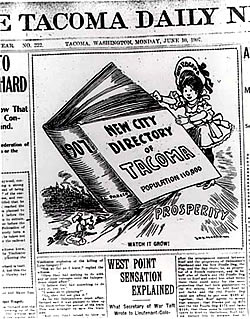 Mechanization—of transportation, resource extraction, and manufacturing—brought immense changes to the Pacific Northwest, then, and cemented the role of extractive industry as the dominant activity in the region. For example, on the eve of the First World War in 1914, and a spurt of war-related manufacturing, timber payrolls accounted for 55 percent of all salaries and wages in the Pacific Northwest. Logging and milling would remain the region's premier industry until another, bigger spurt of war-related manufacturing occurred during World War Two. The identity of the region, even more than before, became that of a place from which raw materials flowed to other locales, and one which needed to import more costly, manufactured goods from distant places with more developed economies.
Mechanization—of transportation, resource extraction, and manufacturing—brought immense changes to the Pacific Northwest, then, and cemented the role of extractive industry as the dominant activity in the region. For example, on the eve of the First World War in 1914, and a spurt of war-related manufacturing, timber payrolls accounted for 55 percent of all salaries and wages in the Pacific Northwest. Logging and milling would remain the region's premier industry until another, bigger spurt of war-related manufacturing occurred during World War Two. The identity of the region, even more than before, became that of a place from which raw materials flowed to other locales, and one which needed to import more costly, manufactured goods from distant places with more developed economies.
If the Northwest as an entire region became known as a resource hinterland, it should nonetheless be noted that the influence of extractive industries was not the same across the region. The three states of Idaho, Washington, and Oregon were all profoundly defined by such enterprises as mining and fishing and logging. However, Oregon remained slightly different. Its founding by farmers during the 1840s and 1850s, located particularly in the Willamette Valley, gave it a distinctive economic and political orientation (as David Alan Johnson has argued in Founding the Far West: California, Oregon and Nevada, 1840-1890 [1992]) that its neighbors did not share. Idaho and Washington, by contrast, took shape under the largely undiluted influence of extractive industries. Not coincidentally, Washington and Idaho became better known than Oregon for the roles that big business and big labor played in them. The Seattle writer Ivan Doig has characterized the differences (in Winter Brothers: A Season at the Edge of America [1980]):
"What I have been calling the Pacific Northwest is multiple. A basic division begins at the Columbia River; south of it, in Oregon, they have been the sounder citizens, we in Washington the sharper strivers. Transport fifty from each state as a colony on Mars and by nightfall the Oregonians will put up a school and a city hall, the Washingtonians will establish a bank and a union."
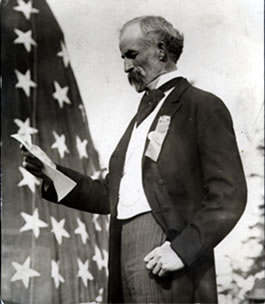
Edmund S. Meany, (left). (Special Collections, University of Washington, negative #17818)
What did people make of the rising industrial production of the later 19th century? While railroads and industrialism both had troublesome aspects to them, they also fulfilled the region's longstanding desires for growth. Boosters looked at the figures of increasing population and increasing output, and concluded that the Pacific Northwest had begun to realize the great potential they had long touted. Moreover, they took advantage of the recent growth to promote the region to still more investors and immigrants and industry. Consider the comments of Edmond S. Meany, the first historian of the Pacific Northwest at the University of Washington. Before he became a university professor in 1895, Meany worked as publicist and booster for Washington at the state's exhibition at the World's Columbian Exposition of 1893. His message at the Chicago world's fair was simple: "The natural resources of the State are vast and inexhaustible." Other promoters of the state also spoke as if its resources and opportunities were infinite. One resident from the Puget Sound area expounded in 1914 or so upon the unlimited things that Washington offered:
Why should I not love Seattle? It took me from the slums of the Atlantic coast, a poor Swedish boy with hardly fifteen dollars in my pocket. It gave me a home by the bountiful sea; it spread before my eyes a vision of snow capped peaks and smiling fields; it brought abundance and a new life to me and my children and I love it, I love it! If I were a multimillionaire I would charter freight cars and carry away from the crowded tenements and noisome alleys of the eastern cities and the Old World the toiling masses, and let them loose in our vast forests and ore-laden mountains to learn what life really is.
In the Northwest it was common, in the years before World War One, to regard Washington's resources as virtually unlimited, and capable of absorbing an enormous increase of population. Observers from outside the region, by contrast, were more skeptical—no doubt because they were less personally engaged in the regional economic growth. At the same world's fair where Meany promoted the Evergreen State as a place of "inexhaustible" natural resources, the historian Frederick Jackson Turner talked about the closing of the American frontier. His remarks, based upon the Census Bureau's 1890 comment that the amount of "free land" available to homesteaders was now in rather short supply, suggested a new sense of limits to the nation. The centuries-long migration from east to west had finally run up against the Pacific Ocean—as well as against the Rocky Mountains and Great Plains and Great Basin—and for this reason and others Americans began to recognize barriers to their economic and territorial aspirations that they had not understood before. The development of federal programs to conserve natural resources—e.g. by creating Forest Reserves (later called National Forests) during the 1890s, or National Parks such as Mt. Rainier in 1899 and Crater Lake in 1902—illustrated how this new sense of limits began to operate on the Pacific Northwest.
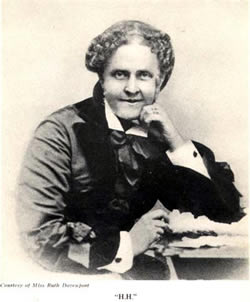 The article "Puget Sound," by Helen Hunt Jackson, published on the eve of the transcontinental railroad's arrival in 1883, provided another outsider's recognition that the region's natural resources were indeed finite.
The article "Puget Sound," by Helen Hunt Jackson, published on the eve of the transcontinental railroad's arrival in 1883, provided another outsider's recognition that the region's natural resources were indeed finite.
Helen Maria Fiske was born in Amherst, Connecticut on October 15, 1830. She married twice, first to Major Edward Bissell Hunt (who died in 1863), and then to Colorado financier William Sharpless Jackson. She began her writing career following the death of her first husband using the nom de plume "H. H." for many of her poems, essays, travel pieces (of which her visit to Puget Sound was one), and novels. She became a zealous convert to Indian reform in 1879 after hearing a lecture on the condition of the Poncas, a midwestern tribe forced to resettle in Indian Territory. She spent the next two years compiling evidence to document the effects of federal Indian policy on Native Americans in the West. The result of this work, A Century of Dishonor: A Sketch of the United State's Government's Dealings with Some of the Indian Tribes, was published in 1881. Helen Hunt Jackson's attention was then drawn to the Mission Indians of California where, in 1883, she was appointed to investigate their conditions and suggest legislation (which was not passed by Congress) to correct injustices. This work lead to her last novel, Ramona, published in 1884, one year before her death. Jackson's concern about the treatment of Indians made her into a reformer, and she brought this perspective to her observations of conditions around Puget Sound. Note that her article appeared in the same year as the transcontinental railroad to the Northwest was finished. Jackson meant to give eastern audiences a glimpse of the newly accessible region. (For more information see Ruth Odell, Helen Hunt Jackson. New York, D. Appleton-Century Company, 1939.)
Helen Hunt Jackson, (right). (Ruth Odell, Helen Hunt Jackson. Photo courtesy of Ruth Davenport. Facing p. 170.)
| Course Home | Previous Lesson | Next Lesson |